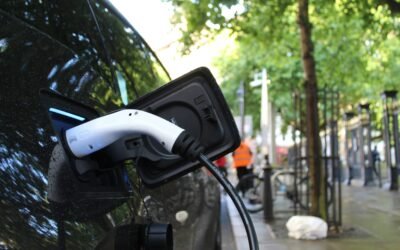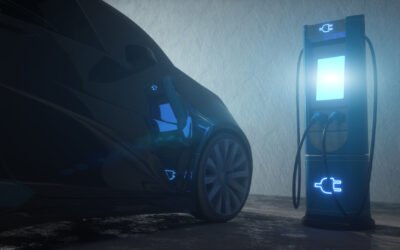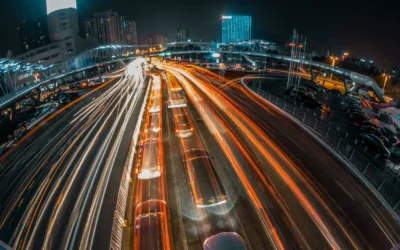• Vehicle to grid technology enables the flow of electricity in both directions, from the grid to the vehicle and from the vehicle to the grid.
• V2G technology can store energy, provide energy reserve to the grid in times of high demand and reduce energy costs of EV owners to a minimum.
• As V2G is in the early stages of development, effective policies and projects will steer us towards reaping the rewards of a more secure, efficient, and interconnected energy landscape.
Vehicle to grid technology (V2G) allows bi-directional flow of electricity from the grid to the vehicle as well as from the vehicle to the grid. Through this process, electric vehicles become a power bank that can provide energy in times of power outages and higher demands. During periods of high-power demand on the grid, electric vehicles that are fully or partially charged can return the energy stored during periods of low demand to the network.

Figure 1: Vehicle to grid (V2G) energy flow diagram using a DC bidirectional charger and a renewable resource.
Source: Clean Energy Review
Around the world, there is an increasing amount of awareness regarding climate change and action is being taken to meet the energy demand with renewable energy resources. The threats of climate change are visible as disastrous events are being observed across the world in recent times. Governments are making a shift towards renewable energy resources, and it is expected that V2G technology will enable the widespread deployment of clean energy resources as it can cater to intermittency in an optimized manner.
Purpose of Bi-Directional Charging
V2G technology serves the purpose of efficiently managing energy demands at local, regional, and national levels through intelligent charging practices. This approach enables EVs to recharge during non-peak periods and contribute energy back to the grid during high-demand peak hours. The concept is practical: EVs that are parked 95% of the time could function as substantial energy reservoirs with strategic planning and suitable infrastructure. Parked and connected EVs have the potential to function as energy reserves, thereby enhancing the stability of future electric grids.
Benefits of Vehicle-to-Grid Technology
V2G technology provides a better alternative to meet the energy demand during peak hours through renewable or non-renewable energy resources. It also avoids the huge cost of producing energy at the electricity generation centers and transporting it over long distances to reach the end consumers. V2G technology benefits utilities, individual EV owners and residents of commercial buildings and houses.
Utilities
V2G technology plays a crucial role in grid balancing and integrating energy backup with the electricity grid. As the energy demand rises, there is a need for more electricity generation at the power plant. Moreover, the electricity has to be transported through transmission lines to the end consumers. With the introduction of V2G technology in the system, the huge costs of electricity generation and transportation can be avoided by using EV batteries as a storage vessel for energy. The energy from the EV battery can be sent into the grid in times of peak demand hours to avoid the extra pressure on the grid. Also, the energy from the EV battery can be used by the owners to power their own houses in times of power outages.
EV drivers and owners
V2G technology does not only provide benefits to utilities but it provides financial benefits to EV drivers and owners. EVs can provide energy for domestic activities in a household as well as to other consumers through the grid. Energy companies are incentivizing their consumers to become responsible and adopt V2G technology. The utility companies give financial compensation to EV owners depending on the amount of energy transported from vehicles to the grid. In this way, EV owners can decrease their utility bills by using the stored energy in the EV battery for domestic uses or by giving energy back to the grid.
Real estate
V2G technology can facilitate renewable energy storage and allow flexible consumption of energy for commercial buildings and houses. EVs can store charge in the batteries and in times of high demand and power instability, the EVs can come to the rescue and provide energy. As renewable energy like solar or wind cannot be produced around the clock, EV batteries can store energy produced from the solar panels installed at the roof top buildings. For individual house owners, their EVs can serve as a power bank. For offices and commercial buildings, the vehicles in the parking lot can be deployed to provide energy in cases of power instability. This will decrease the carbon footprint of the people in the building if their energy comes from renewable energy resources.
Figure 2 shows the 3 crucial stakeholders collaborating in the implementation of V2G technology. Utility companies, vehicle companies and end consumers benefit from the introduction of V2G technology into the electrical grid systems.

Figure 2: Stakeholder and actor integration to policy measures in the vehicle-to-grid technology supply chain.
Source: MDPI
Way Forward
Incorporating V2G technology into EV chargers marks an essential step towards a sustainable and resilient future. As the US and Europe accelerate their transition towards e-mobility and confront challenges faced by their energy infrastructure, V2G emerges as a beacon of opportunity. By implementing proactive decision-making using V2G technology, we can surmount barriers and unlock the transformative potential of bidirectional charging and efficiently transport and store electricity. As we stand at the cusp of this technological revolution, effective policies and projects will steer us towards reaping the rewards of a more secure, efficient, and interconnected energy landscape.
EV Charging Infrastructure Service Overview
The research presented in this article is from PTR's EV Charging Infrastructure market research. For information about this service please submit a request shown below.
Contact Sales:
Europe
+49-89-12250950
Americas
+1 408-604-0522
Japan
+81-80-7808-1378
GCC/Rest of APAC
+971-58-1602441
More about our:
EV Charging Infrastructure Market Research
Recent Insights
Exploring the European EVCI Services Market Key Players and Emerging Trends
There has been a significant surge in the development of EVCI due to the widespread adoption of EVs in Europe. By 2030, it is expected that Europe...
Nordics EVCI Market Comparison: Quarterly Growth and Market Dynamics – 2024
This infographic examines the ambitious policies and regional targets that are propelling the growth of Electric Vehicle Charging Infrastructure...
Electrifying Future: Emerging Trends and Strategic Targets in the Middle East
This infographic presents an overview of the burgeoning electric vehicle (EV) market in the Middle East. It highlights the region's ambitious...


